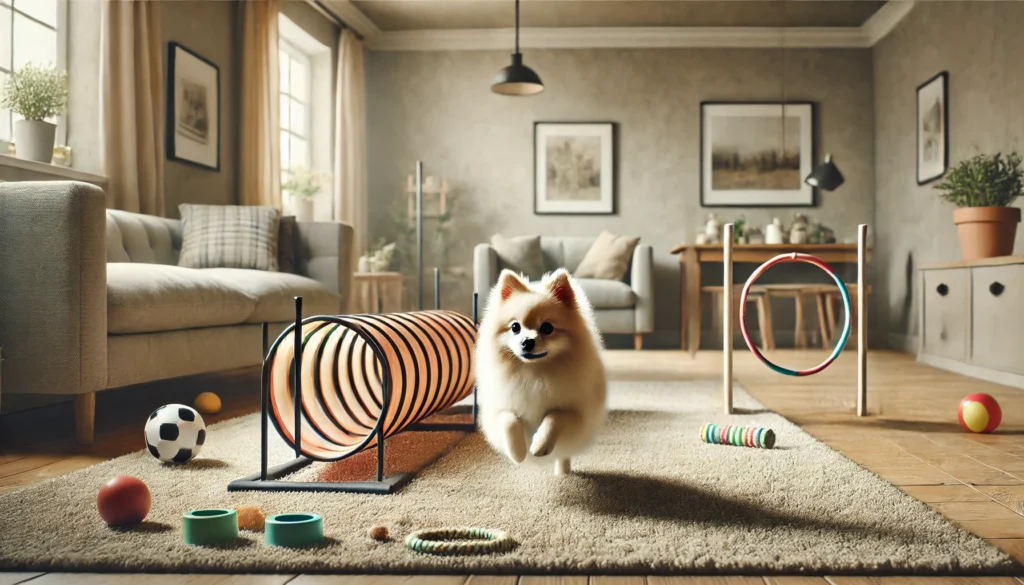Small dogs often have big energy — but not always the space to burn it off. Whether you live in an apartment, are facing bad weather, or simply want to add more structure to your dog’s day, there are plenty of ways to keep your little pup fit and happy indoors.
This guide covers safe, fun, and effective indoor exercises tailored for small breed dogs.
Why Small Dogs Still Need Exercise
It’s a myth that small dogs don’t require much physical activity. While they don’t need miles of running like larger breeds, they still benefit from:
- Cardiovascular health and weight management
- Mental stimulation and boredom prevention
- Stronger bones and muscles
- Improved behavior and emotional balance
Indoor play doesn’t replace outdoor walks entirely, but it’s a crucial supplement or substitute when outdoor time is limited.
How Much Exercise Do Small Dogs Need?
Most small dogs should get 30–60 minutes of daily exercise, depending on:
- Age (puppies and young adults need more)
- Breed (terriers, for example, are high-energy)
- Health status and joint condition
Indoor routines can meet much of this requirement when planned consistently.
Best Indoor Exercises for Small Dogs
Let’s explore engaging ways to keep your pup moving indoors.
1. Hallway Fetch or Chase
Use your hallway like a mini dog run.
- Toss a soft toy down the hall for short sprints
- Use a squeaky ball for added excitement
- Teach your dog to “wait” and “go” for mental control
Use rugs or foam mats to prevent slipping.
2. Stairs Game (If Safe)
If you have carpeted stairs:
- Toss a toy or treat up a few steps
- Let your dog run up and down 3–5 times
- Supervise carefully to avoid slipping or overexertion
Avoid for senior dogs or those with joint issues.
3. Tug-of-War
Great for energy and bonding.
- Use a strong but soft toy with a handle
- Let your dog tug, pull, and “win” to boost confidence
- Stop if they become overstimulated
Keep sessions short and always supervised.
4. Treat Hunt
Hide treats around a room or two.
- Let your dog use their nose to search and sniff
- Start easy and gradually increase difficulty
- Encourage exploration under pillows or behind furniture (safely)
It builds scent skills and keeps their mind active.
5. Obstacle Course
Use household objects to create a mini agility track.
- Jump over broomsticks laid across cushions
- Crawl under chairs or through tunnels made of boxes
- Weave between stools or toys
Guide your dog with treats and praise. Keep it safe and non-slippery.
6. Interactive Toys and Puzzles
Mental stimulation burns energy too.
- Puzzle feeders, snuffle mats, or rolling treat balls
- Hide-and-seek with a favorite toy
- “Find it” games using their nose
Rotate toys every few days to maintain interest.
7. Basic Training Refresher
Training is both mental and physical work.
- Practice sit, stay, down, and come
- Teach new tricks like spin, high-five, or crawl
- Use short, focused 5-minute sessions
Always end on a positive note with a reward.
8. Doggy Treadmill (Optional)
If you have one or want to invest:
- Use it under supervision with positive reinforcement
- Start slow and low — never force them to stay on
- Keep sessions short and build gradually
This is best for very energetic dogs or those in bad-weather regions.
Safety Tips for Indoor Workouts
- Always provide water nearby
- Use non-slip surfaces to avoid injury
- Don’t overdo jumping or twisting for breeds with back issues (e.g. Dachshunds)
- Monitor breathing and energy levels
- Offer a cozy rest zone for cooldown after activity
Rest is as important as exercise!
Build It Into Your Routine
Schedule indoor activity as part of your daily flow:
- Morning: a game of fetch or training
- Afternoon: puzzle or nose work
- Evening: tug or hide-and-seek
Consistency helps burn off energy and prevent behavioral issues.
Little Dogs, Big Benefits
Just because they’re small doesn’t mean they don’t need big outlets for energy. With the right mix of physical activity and mental engagement, your small dog can thrive indoors—staying healthy, happy, and ready to cuddle when it’s time to rest.






